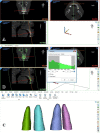Investigating the Effectiveness of Low-Level Laser in Reducing Root Resorption of the Upper Incisors During Intrusion Movement Using Mini-Implants in Adult Patients With Deep Overbite: A Randomized Controlled Clinical Trial
- PMID: 36846638
- PMCID: PMC9950033
- DOI: 10.7759/cureus.35381
Investigating the Effectiveness of Low-Level Laser in Reducing Root Resorption of the Upper Incisors During Intrusion Movement Using Mini-Implants in Adult Patients With Deep Overbite: A Randomized Controlled Clinical Trial
Abstract
Background: Deep bite is a common characteristic of malocclusion, and many methods are used to treat it, including mini-implants used for the intrusion of the upper incisors. Orthodontically induced inflammatory root resorption (OIIRR) is an inevitable and unexpected side effect of orthodontic therapy. However, resorption of the root could be affected by the type of tooth movement, such as intrusion. Several studies have indicated the effectiveness of low-level laser therapy (LLLT) in accelerating orthodontic movement, but studies that have evaluated the role of this laser in reducing the risk of OIIRR have been limited. This trial aimed to investigate the effectiveness of LLLT in reducing the resorption of the roots of the upper incisors during their intrusion in the context of deep bite correction.
Materials and methods: Thirty patients (13 males, 17 females; mean age 22.4±3.37 years) with deep overbite were recruited and allocated to the laser or the control groups. Mini-implants were inserted between the roots of the upper central incisors and the lateral incisors from the labial aspect at the gingival-mucosal junction on both sides with a force of 40 g on each side through an NiTi coil spring. A low-level laser (Ga-Al-As) with 808 nm wavelength in a continuous mode, with the parameters 250 milliwatt power output, 4 Joules/point energy density, and 16 seconds irradiation per point, was applied to the root of each of the upper incisors. The laser was applied on the first day of the upper incisor intrusion (T1), then on days 3, 7, and 14 of the first month. In the second month, the laser was applied every 15 days, adjusting the spring strength every four weeks until the end of the intrusion stage (T2), which was determined by reaching a normal overbite. As for patients in the control group, the strength of the nickel-titanium springs was adjusted every four weeks to the required strength of 40 g on each end until reaching a normal overbite.
Results: There was a volumetric decrease in both groups' upper central and lateral incisors roots, and this decrease was statistically significant (P<0.001). However, the difference between the two groups was not statistically significant in each central and lateral incisor volume root (P=0.345 and 0.263 for U1 and U2, respectively). Also, both groups had a linear decrease in upper central and lateral incisors roots, which was statistically significant (P<0.001). At the same time, the difference between the two groups was not statistically significant in each central and lateral incisor root length (P=0.343 and 0.461 for U1 and U2, respectively).
Conclusion: The low-level laser irradiation using the current protocol did not significantly affect the amount of root resorption induced by incisor intrusion in the experimental group compared to the control group.
Keywords: adult patients; cone beam computed tomography – cbct; deep bite; intrusion; low-level laser; mini-implants; overbite; root resorption; upper incisor intrusion; volumetric analysis.
Copyright © 2023, Nasser et al.
Conflict of interest statement
The authors have declared that no competing interests exist.
Figures






Similar articles
-
Comparison of anterior and posterior mini-implant-assisted maxillary incisor intrusion: Root resorption and treatment efficiency.Angle Orthod. 2016 Sep;86(5):746-52. doi: 10.2319/085015-571.1. Epub 2016 Jan 7. Angle Orthod. 2016. PMID: 26741306 Free PMC article.
-
Comparative cone-beam computed tomographic evaluation of maxillary incisor intrusion and associated root resorption: Intrusion arch vs mini-implants.Am J Orthod Dentofacial Orthop. 2023 Mar;163(3):e84-e92. doi: 10.1016/j.ajodo.2022.12.007. Epub 2023 Jan 11. Am J Orthod Dentofacial Orthop. 2023. PMID: 36635144
-
One versus two anterior miniscrews for correcting upper incisor overbite and angulation: a retrospective comparative study.Prog Orthod. 2020 Sep 7;21(1):34. doi: 10.1186/s40510-020-00336-2. Prog Orthod. 2020. PMID: 32893322 Free PMC article.
-
Effectiveness of miniscrew-supported maxillary incisor intrusion in deep-bite correction: A systematic review and meta-analysis.Angle Orthod. 2020 Mar;90(2):291-304. doi: 10.2319/061119-400.1. Epub 2019 Dec 9. Angle Orthod. 2020. PMID: 31816252 Free PMC article.
-
Influence of mini-screw implant-assisted intrusion on orthodontically induced inflammatory root resorption: a systematic review.Eur Arch Paediatr Dent. 2021 Jun;22(3):341-349. doi: 10.1007/s40368-020-00588-w. Epub 2021 Jan 10. Eur Arch Paediatr Dent. 2021. PMID: 33423207
Cited by
-
Effect of Low-Intensity Electrical Stimulation on External Apical Root Resorption and Periodontal Indices Following En-Masse Retraction of Upper Anterior Teeth in Young Adults: A Randomized Controlled Trial.Clin Exp Dent Res. 2025 Aug;11(4):e70188. doi: 10.1002/cre2.70188. Clin Exp Dent Res. 2025. PMID: 40762524 Free PMC article. Clinical Trial.
References
-
- Deep bite its etiology, diagnosis and management: A review. Daokar S, Agrawal G. J Orthod. 2016;2:12.
-
- Deep overbite correction by intrusion. Burstone CR. http://www.ncbi.nlm.nih.gov/pubmed/267433. Am J Orthod. 1977;72:1–22. - PubMed
-
- Correction of deep overbite in adults. Nanda R. http://www.ncbi.nlm.nih.gov/pubmed/9023063. Dent Clin North Am. 1997;41:67–87. - PubMed
-
- Vertical malocclusions: Etiology, development, diagnosis and some aspects of treatment. Nielsen IL. Angle Orthod. 1991;61:247–260. - PubMed
-
- The possibility of skeletal anchorage. Creekmore TD, Eklund MK. http://www.ncbi.nlm.nih.gov/pubmed/6574142. J Clin Orthod. 1983;17:266–269. - PubMed
LinkOut - more resources
Full Text Sources
Research Materials
